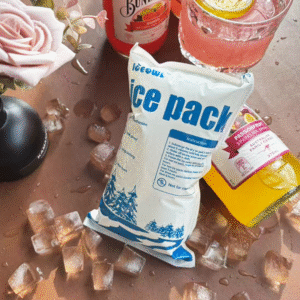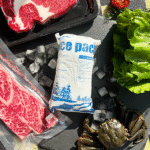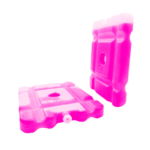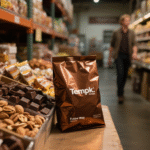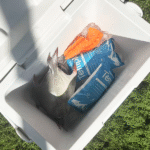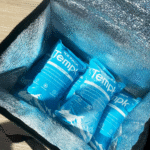Como usar bolsas de gelo seco reutilizáveis para transporte de carne
Quando você está enviando carne, mantê-lo frio sem desperdício é o desafio final. Pacotes de gelo seco reutilizáveis para carne oferecer uma resposta confiável e ecológica. Esses pacotes combinam o poder ultrafrio do gelo seco com a conveniência de um gel reutilizável ou material de mudança de fase, tornando-os ideais para remessas refrigeradas e congeladas. Neste guia, você aprenderá como esses pacotes funcionam, por que eles são diferentes do gelo seco descartável, e como usá-los de forma eficaz na evolução da cadeia de frio de 2025. Ao longo do caminho, vamos compará-los com pacotes de gel e gelo seco tradicional, explorar as tendências do setor, e fornecer dicas práticas para que você possa entregar carne de forma segura e sustentável.
Entenda o que são bolsas de gelo seco reutilizáveis para carne e por que eles são importantes na logística moderna da cadeia de frio.
Aprenda a preparar e embalar carne com bolsas de gelo seco reutilizáveis para maximizar o resfriamento e evitar deterioração.
Compare bolsas de gelo seco reutilizáveis com bolsas de gel e gelo seco tradicional, incluindo uma tabela de prós e contras e quando escolher cada opção.
Obtenha dicas práticas e cenários para empresas e indivíduos que enviam carne, esteja você enviando bifes para um amigo ou gerenciando um serviço de assinatura.
Explorar 2025 tendências e inovações na tecnologia da cadeia de frio, incluindo sustentabilidade, IA, Robótica, e mudanças regulatórias.
O que torna os pacotes de gelo seco reutilizáveis para carne ideais?
Bolsas de gelo seco reutilizáveis são bolsas ou painéis duráveis preenchidos com materiais de mudança de fase (PCMs) ou gel que pode ser congelado em temperaturas extremamente baixas. Ao contrário do gelo seco de uso único, eles não sublimam em gás. Em vez de, eles absorvem calor e mantêm temperaturas estáveis dentro de uma faixa estreita (normalmente entre −20°C e +2°C) antes de aquecer gradualmente. Porque eles são classificados como não perigosos, eles não exigem os regulamentos de manuseio de materiais perigosos associados ao dióxido de carbono sólido.
Benefícios:
Economia de custos a longo prazo: Embora o custo inicial seja maior, embalagens reutilizáveis podem ser usadas dezenas de vezes, reduzindo o custo total por remessa.
Desperdício reduzido: Reutilizando os mesmos pacotes, as empresas reduziram as emissões de CO₂ e a eliminação de resíduos em comparação com gelo seco descartável ou pacotes de gel.
Controle de temperatura consistente: Os PCMs podem ser projetados para manter faixas de temperatura específicas – perfeitos para manter a carne refrigerada ou congelada.
Conformidade simplificada: Porque esses pacotes não são perigosos, eles contornam muitos dos obstáculos regulatórios enfrentados pelo gelo seco, facilitando o envio.
Aplicações versáteis: Além da carne, bolsas de gelo seco reutilizáveis são usadas para produtos farmacêuticos, kits de refeições, e até aplicações veterinárias.
Desvantagens:
Logística de devolução: Para obter benefícios de custo, os usuários devem coletar e congelar novamente os pacotes. Se as taxas de retorno forem baixas, o investimento pode não compensar.
Necessidades de infraestrutura: Você precisará de freezers capazes de atingir o ponto de congelamento da embalagem e de um processo de limpeza para garantir a higiene.
Capacidade limitada de congelamento profundo: Embora as embalagens reutilizáveis mantenham temperaturas frias ou moderadamente congeladas, eles podem não atingir as temperaturas ultra frias do gelo seco (-78,5 ° C.) para determinados produtos.
Como eles se comparam aos pacotes tradicionais de gelo seco e gel
O gelo seco tradicional é a forma sólida de dióxido de carbono que sublima diretamente de sólido para gasoso a -78,5°C.. Proporciona temperaturas extremamente baixas e muitas vezes é a única opção para produtos ultracongelados, como sorvetes ou carnes congeladas destinadas a trânsito prolongado.. Pacotes de gel, por outro lado, são bolsas flexíveis preenchidas com um gel não tóxico que congela e mantém temperaturas frias por 24 a 48 horas. Eles são reutilizáveis, mas fornecem menos potência de resfriamento e são adequados principalmente para produtos refrigerados, como produtos hortifrutigranjeiros ou refeições preparadas..
Bolsas de gelo seco reutilizáveis preenchem a lacuna. Eles oferecem um resfriamento mais profundo do que os pacotes de gel e evitam os perigos do gelo seco tradicional, tornando-os ideais quando você precisa manter a carne congelada, mas deseja minimizar o desperdício e a complexidade regulatória.
Construa um modelo mental
Pense nesses pacotes como baterias recarregáveis para frio. O gelo seco é uma bateria descartável que queima rapidamente e libera gás, enquanto uma bolsa de gelo seco reutilizável é uma bateria recarregável – carregue-a no freezer e reutilize-a novamente. Os pacotes de gel são como baterias alcalinas descartáveis: útil para necessidades leves de energia, mas não forte o suficiente para cargas pesadas.
Como preparar e usar bolsas de gelo seco reutilizáveis para carne
Usar bolsas de gelo seco reutilizáveis para carne não é complicado, mas a preparação adequada é essencial para garantir que sua carne permaneça fria e segura. Siga estas etapas:
Congele os pacotes totalmente: Coloque as embalagens em um freezer capaz de atingir a temperatura recomendada (frequentemente −20°C ou menos). Reserve tempo suficiente – geralmente 24 horas – para garantir que estejam completamente congelados.
Pré-resfrie o recipiente: Resfrie seu refrigerador ou caixa isolada antes de carregá-lo. O pré-resfriamento reduz o choque térmico e retarda o aquecimento da embalagem.
Use isolamento adequado: Escolha um recipiente com paredes grossas e vedações herméticas. O isolamento de alto desempenho reduz a entrada de calor e retarda a sublimação ou derretimento.
Divida os pacotes: Coloque um pacote congelado no fundo do recipiente, adicionar uma barreira (como papelão ou um pequeno rack) para evitar o contato direto com a carne, e depois coloque a carne. Adicione pacotes adicionais no topo, garantindo que o ar frio possa circular.
Minimize o espaço vazio: Preencha os espaços vazios com plástico bolha ou papel de embalagem. Bolsos vazios permitem que o ar quente circule e acelere o aquecimento.
Monitorar temperatura: Se você estiver enviando para longas distâncias, inclui um registrador de dados de temperatura. Alguns pacotes reutilizáveis integram rastreamento IoT, permitindo que você monitore as condições em tempo real.
Lidar com devoluções: Após a entrega, garantir que haja um sistema para coleta e devolução dos pacotes. Limpe e congele-os novamente imediatamente para manter a higiene.
Seguindo estas etapas, você aproveitará ao máximo suas bolsas de gelo seco reutilizáveis e, ao mesmo tempo, garantirá que sua carne chegue nas melhores condições. Lembrar, esses pacotes são projetados para vários ciclos, então trate-os com cuidado para maximizar sua vida útil.
Ferramenta de decisão: Você deve usar bolsas de gelo seco reutilizáveis?
Para decidir se bolsas de gelo seco reutilizáveis são adequadas para sua remessa, considere a seguinte lista de verificação rápida. Se você responder “sim” à maioria das perguntas, pacotes reutilizáveis são provavelmente uma boa opção:
| Pergunta | Sim/Não | O que isso significa |
| Você envia carne regularmente (semanal ou mensal)? | O envio frequente faz com que o investimento inicial valha a pena. | |
| Você pode garantir a devolução dos pacotes? | Um processo de devolução confiável é essencial para reutilização e economia de custos. | |
| Seus produtos estão congelados, mas não ultrafrios (acima de −20°C)? | As embalagens reutilizáveis mantêm temperaturas frias ou moderadamente congeladas, mas não são tão frias quanto o gelo seco. | |
| Você tem espaço no freezer para pré-condicionar os pacotes? | Você precisará congelá-los antes de cada uso. | |
| Você está procurando reduzir o manuseio e desperdício de materiais perigosos? | As embalagens reutilizáveis não são perigosas e reduzem o desperdício. |
Use esta ferramenta para orientar sua escolha. Se a sua resposta for “não” para a maioria das perguntas, você pode preferir pacotes de gel para itens resfriados ou gelo seco tradicional para remessas extremamente frias.
Pacotes de gelo seco reutilizáveis vs pacotes de gel vs gelo seco tradicional
Compreender como os pacotes de gelo seco reutilizáveis se comparam aos pacotes de gel e ao gelo seco tradicional ajuda você a escolher a ferramenta certa para sua remessa. A tabela abaixo resume as principais diferenças:
| Atributo | Pacotes de gelo seco reutilizáveis | Pacotes de gel | Gelo seco tradicional | Significado para sua remessa de carne |
| Potência de resfriamento | Mantém temperaturas de -20°C a +2°C; adequado para carne congelada ou resfriada | Mantém os itens frescos em torno de 2–8°C por 24–48 horas | Fornece temperaturas ultra frias (≈−78°C), ideal para remessas congeladas | Escolha embalagens reutilizáveis para congelamento moderado, pacotes de gel para carnes resfriadas, e gelo seco para necessidades ultrafrias. |
| Reutilização | Projetado para multiuso; requer logística de devolução e recongelamento | Reutilizável; simplesmente congele novamente após cada uso | Uso único; sublima e não pode ser recondicionado | As embalagens reutilizáveis reduzem o desperdício ao longo do tempo; pacotes de gel também são reutilizáveis, mas fornecem menos poder de resfriamento. |
| Classificação de perigo | Não perigoso; transporte e descarte mais simples | Não perigoso e não tóxico | Perigoso; requer rotulagem e manuseio especiais | Se você quiser evitar regulamentações sobre materiais perigosos, escolha pacotes reutilizáveis ou de gel. |
| Duração | Normalmente 48–72 horas quando usado corretamente; depende do isolamento | 24–48 horas | 12–24 horas para pellets; mais tempo para blocos maiores | Para viagens longas, você pode precisar de vários pacotes ou de uma solução híbrida. |
| Perfil de custo | Custo inicial mais alto, mas menor custo por ciclo quando reutilizado | Baixo custo por unidade; infraestrutura mínima | Baixo custo inicial, mas despesas recorrentes em cada remessa e taxas adicionais para manuseio de materiais perigosos | Se os orçamentos forem apertados no curto prazo, pacotes de gel ou gelo seco podem parecer mais baratos; para poupanças a longo prazo, pacotes reutilizáveis ganham. |
| Impacto Ambiental | Redução de resíduos e emissões de CO₂; se alinha com as metas de sustentabilidade | Baixo impacto ambiental; facilmente descartado como água | Sublima em gás CO₂; contribui para gases de efeito estufa e requer ventilação adequada | Os expedidores preocupados com a sustentabilidade devem preferir embalagens reutilizáveis ou de gel. |
| Lidando com a Complexidade | Moderado: requer logística de congelamento e devolução | Simples: congelar e colocar; treinamento mínimo | Alto: manuseio perigoso, ventilação, e protocolos de segurança | Considere o treinamento da equipe e a conformidade regulatória ao escolher gelo seco. |
Ao selecionar um meio de resfriamento, pesar cada fator. Por exemplo, se você estiver enviando carne congelada de alto valor para todo o país e precisar que ela permaneça a -20°C por 48 horas, bolsas de gelo seco reutilizáveis com isolamento adequado podem ser ideais. Se você estiver enviando bifes durante a noite, pacotes de gel podem ser suficientes. Para sorvetes ou frutos do mar delicados que exigem condições ultra frias, gelo seco tradicional ainda pode ser necessário.
Visão geral dos prós e contras
Pacotes de gelo seco reutilizáveis: Baixo desperdício, reutilizável, não perigoso, mas exigem logística de devolução e congelamento adequado.
Pacotes de gel: Seguro, flexível, reutilizável, econômico para itens refrigerados, mas com duração de resfriamento limitada e pode adicionar peso.
Gelo seco tradicional: Extremamente frio e excelente para carnes congeladas ou sorvetes, mas perigoso de manusear, regulamentado, e uso único.
Dicas práticas e cenários do mundo real
H3: Pequenos Produtores Enviando Pedidos Regionais
Se você administra uma pequena fazenda ou açougue, envia produtos dentro do seu estado, bolsas de gelo seco reutilizáveis alcançam um equilíbrio entre desempenho e simplicidade. Use uma caixa isolada grossa, congelar as embalagens a pelo menos −20°C, e planeje uma janela de trânsito de 24 a 48 horas. Incentive os clientes a devolver os pacotes, oferecendo um pequeno desconto no próximo pedido. Este ciclo de devolução reduz o desperdício e reduz os custos gerais de envio.
H3: Serviços de assinatura e kits de refeição
Os serviços de refeições por assinatura geralmente entregam caixas semanais de carne e produtos. Os pacotes reutilizáveis são excelentes aqui porque você pode coordenar a logística de devolução por meio de sua rede de assinatura. Etiquete cada pacote com um código QR para que os clientes possam digitalizar e agendar uma coleta ou entrega. Certifique-se de que seu armazém tenha capacidade de freezer suficiente para recarregar os pacotes entre as remessas. Ao longo do tempo, seu custo por pedido cai, e você promove uma imagem de marca ecologicamente correta.
H3: Cortes premium diretos ao consumidor
Ao enviar cortes de alto valor, como wagyu ou bife alimentado com capim em todo o país, combinar bolsas de gelo seco reutilizáveis com gelo seco tradicional pode ser benéfica. Comece com uma camada de fatias de gelo seco para o congelamento inicial; em seguida, use embalagens reutilizáveis acima e abaixo da carne para manter uma temperatura consistente enquanto o gelo seco se dissipa. Esta abordagem híbrida protege contra o sobrearrefecimento ao mesmo tempo que prolonga a duração do arrefecimento.
H3: Situações de emergência ou cortes de energia
Bolsas de gelo seco reutilizáveis não servem apenas para envio; eles são úteis em emergências. Durante cortes de energia ou apagões, coloque pacotes congelados em sua geladeira ou freezer para manter temperaturas seguras para carne e outros produtos perecíveis. Sua flexibilidade também os torna adequados para camping ou viagens rodoviárias onde o acesso ao gelo é limitado.
Caso do mundo real: Uma empresa de salsichas artesanais no noroeste do Pacífico fez a transição de gelo seco descartável para embalagens reutilizáveis em 2024. Coordenando um programa de devolução com os clientes e adicionando códigos QR para devoluções fáceis, eles alcançaram uma taxa de retorno de 90% e economizaram 40% em custos de refrigerante em seis meses. Suas remessas permaneceram frias por 48 horas, e a satisfação do cliente melhorou porque não havia gelo seco bagunçado para manusear.
2025 Tendências em cadeia de frio e embalagens reutilizáveis
A indústria da cadeia fria está evoluindo rapidamente. Aqui estão as principais tendências que moldam o uso de bolsas de gelo seco reutilizáveis e o transporte de carne:
Melhor distribuição e atualizações de instalações: Em 2025, as indústrias estão otimizando as rotas de abastecimento e ampliando as instalações de armazenamento para atender à crescente demanda. Armazéns atualizados com melhor isolamento e capacidade de armazenamento refrigerado permitem um pré-condicionamento e armazenamento mais confiáveis de embalagens reutilizáveis.
Aumento de proteínas vegetais e alimentos alternativos: À medida que o mercado baseado em plantas cresce em direção a US$ 162 bilhões projetados até 2030, mais produtores estão enviando alternativas de carne que ainda exigem soluções robustas de cadeia de frio. As embalagens reutilizáveis oferecem uma opção ecológica para que essas empresas entreguem produtos com segurança.
Visibilidade aprimorada da cadeia de suprimentos e IA: As empresas estão investindo em monitoramento em tempo real, Rastreamento de IoT, e análises preditivas para gerenciar a temperatura e a localização durante toda a viagem. Pacotes reutilizáveis geralmente integram sensores, permitindo monitorar temperaturas e melhorar a responsabilidade.
Sustentabilidade e economia circular: As pressões de sustentabilidade estão a pressionar as empresas a reduzir as emissões e os resíduos. O mercado de embalagens reutilizáveis da cadeia de frio deverá crescer de US$ 4,97 bilhões em 2025 para US$ 9,13 bilhões em 2034 em um CAGR de 6,98%. Esta mudança está alinhada com a adoção de bolsas de gelo seco reutilizáveis que reduzem o desperdício e a pegada de carbono.
Automação e robótica: Sistemas automatizados de armazenamento e recuperação e manuseio robótico em armazéns frigoríficos ajudam a gerenciar embalagens pesadas e a reduzir a exposição humana a ambientes frios. Isso facilita o processamento de devoluções e o recongelamento eficiente de embalagens.
Desafios e alternativas no fornecimento de gelo seco: O mercado de gelo seco está sob pressão devido às restrições e volatilidade no fornecimento de CO₂. Alternativas como PCMs e embalagens reutilizáveis estão ganhando terreno para reduzir a dependência de gelo seco.
Resumo dos últimos avanços
Materiais de mudança de fase: Os PCMs são projetados para manter faixas de temperatura específicas e não são perigosos. Eles estão cada vez mais integrados em embalagens reutilizáveis para carnes e produtos biológicos.
IoT e rastreamento inteligente: Sensores incorporados em pacotes fornecem dados de temperatura em tempo real, permitindo intervenções proativas quando as temperaturas oscilam.
Painéis isolados a vácuo: O isolamento avançado reduz o número de pacotes necessários e prolonga a duração do resfriamento.
Soluções Híbridas: A combinação de embalagens reutilizáveis com gelo seco ou bolsas de gel adapta perfis de temperatura para produtos específicos.
Plataformas Logísticas Circulares: As empresas estão desenvolvendo plataformas logísticas de devolução com sistemas de rastreamento e limpeza para garantir que as embalagens sejam recuperadas, higienizado, e reimplantado de forma eficiente.
Insights de mercado
Analistas de mercado estimam que a indústria de embalagens reutilizáveis da cadeia de frio crescerá de US$ 4,97 bilhões em 2025 para mais de 9 mil milhões de dólares 2034. Este crescimento é impulsionado por demandas de sustentabilidade, pressão regulatória para reduzir materiais perigosos, e os setores em expansão do comércio eletrônico e da entrega de kits de refeição. Além disso, escassez de oferta e preços voláteis no mercado de gelo seco – onde a demanda cresce aproximadamente 5 % anualmente, enquanto o fornecimento de CO₂ só aumenta em 0.5 %—estão empurrando os transportadores para alternativas reutilizáveis.
Perguntas frequentes
Q1: Os pacotes de gelo seco reutilizáveis são seguros para o transporte de carne??
Sim. Bolsas de gelo seco reutilizáveis são projetadas para segurança alimentar e não são tóxicas. Eles mantêm temperaturas estáveis e evitam os perigos associados ao gelo seco, como congelamento e acúmulo de gás CO₂.
Q2: Por quanto tempo as bolsas de gelo seco reutilizáveis mantêm a carne congelada?
Com isolamento e pré-condicionamento adequados, embalagens reutilizáveis podem manter a carne congelada por 48 a 72 horas. A duração varia de acordo com a temperatura ambiente, qualidade do contêiner, e o número de embalagens usadas. Para tempos de trânsito mais longos, considere combiná-los com gelo seco ou isolamento adicional.
Q3: Os pacotes de gelo seco reutilizáveis podem substituir o gelo seco tradicional?
Eles podem substituir o gelo seco para muitas remessas resfriadas ou moderadamente congeladas, mas não para cargas ultrafrias.. O gelo seco tradicional atinge -78,5°C e ainda é necessário para produtos ultracongelados, como sorvetes ou produtos biológicos sensíveis.
Q4: Qual é a diferença entre bolsas de gelo seco reutilizáveis e bolsas de gel?
Ambos são reutilizáveis, mas as bolsas de gelo seco usam PCMs ou géis que congelam em temperaturas mais baixas, proporcionando resfriamento mais frio e duradouro. Os pacotes de gel são melhores para produtos refrigerados entre 2 e 8°C, enquanto bolsas de gelo seco reutilizáveis servem para carnes congeladas.
Q5: Preciso de licenças especiais para enviar bolsas de gelo seco reutilizáveis?
Não. Como as embalagens reutilizáveis não são perigosas, eles não exigem rotulagem especial ou manuseio exigido para gelo seco. No entanto, você ainda deve seguir os regulamentos gerais de segurança alimentar e embalagem.
Resumo e recomendações
As bolsas de gelo seco reutilizáveis para carne combinam o desempenho em baixas temperaturas do gelo seco com a conveniência e a sustentabilidade das embalagens reutilizáveis. Eles mantêm a carne em temperaturas seguras por dias, não são perigosos, e reduzir o desperdício em comparação com pacotes de gelo seco e gel descartáveis. No entanto, eles exigem investimento em logística de congelamento e devolução, e podem não atingir as temperaturas ultra frias do gelo seco tradicional.
Para decidir se os pacotes reutilizáveis são adequados para você:
Avalie sua frequência e distância de envio.
Verifique sua capacidade de recuperar pacotes após a entrega.
Determine se seus produtos precisam ser congelados (-20 ° C.) ou condições ultra frias (−78°C).
Planeje o espaço do freezer e protocolos de limpeza.
Considere combinar embalagens reutilizáveis com embalagens de gel ou gelo seco para soluções híbridas.
Geral, bolsas de gelo seco reutilizáveis são uma excelente escolha para empresas e indivíduos que buscam um ambiente sustentável, maneira econômica de transportar carne e, ao mesmo tempo, atender às crescentes expectativas dos consumidores em relação à responsabilidade e confiabilidade ambiental.
Sobre Tempk
A Tempk é fornecedora líder de soluções de embalagem para cadeia de frio, incluindo bolsas de gelo seco reutilizáveis, recipientes isolados, e ferramentas de monitoramento inteligentes. Nossos produtos são projetados para manter seus produtos perecíveis na temperatura certa, reduzindo o desperdício e simplificando a conformidade. Empregamos materiais avançados como géis de mudança de fase e painéis isolados a vácuo, e nossa equipe inova continuamente para atender às crescentes necessidades de alimentos, farmacêutico, e transportadores de biotecnologia. Com um compromisso com a sustentabilidade e o sucesso do cliente, nós ajudamos você a enviar de maneira mais inteligente.
Chamado à ação: Se você está pronto para melhorar seu processo de envio de carne, entre em contato com a Tempk para obter aconselhamento personalizado e descubra como nossos sacos de gelo seco reutilizáveis podem manter seus produtos frescos e seus clientes satisfeitos.






